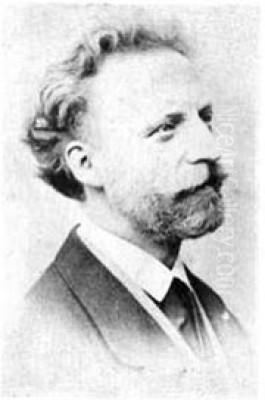
Gustav Bauernfeind stands as one of the most distinguished German Orientalist painters of the 19th century. His work is celebrated for its extraordinary attention to architectural detail, vibrant depiction of light and atmosphere, and its almost photographic realism in capturing the essence of the Middle East. Born on September 4, 1848, in Sulz am Neckar, Germany, and passing away on December 24, 1904, in Jerusalem, Bauernfeind's life and art offer a fascinating window into a world that was rapidly changing, and a European artistic movement captivated by its allure.
Early Life and Artistic Formation
Gustav Bauernfeind's journey into the art world began not directly with painting, but with architecture. He initially studied architecture at the Polytechnic University in Stuttgart, a background that would profoundly influence his later artistic endeavors. This architectural training instilled in him a deep appreciation for structure, form, and precision, qualities that became hallmarks of his paintings. His meticulous rendering of complex buildings, intricate stonework, and bustling cityscapes can be directly traced back to these formative years.
Following his architectural studies, Bauernfeind transitioned to fine arts, enrolling at the prestigious Munich Academy of Fine Arts. Here, he came under the tutelage of notable artists, including Wilhelm von Diez (1839-1907). Diez was a significant figure in the Munich School, known for his historical and genre paintings, and his emphasis on realism and technical skill would have resonated with Bauernfeind's own inclinations. The Munich School itself, with artists like Franz von Lenbach (1836-1904) and Wilhelm Leibl (1844-1900) – though Leibl leaned more towards a starker realism – was a crucible of artistic innovation, blending academic tradition with emerging realist trends. Bauernfeind's early works, though not widely known, likely reflected these influences, focusing on German and Italian landscapes and architectural studies.
The Allure of Italy and the Turn to the Orient
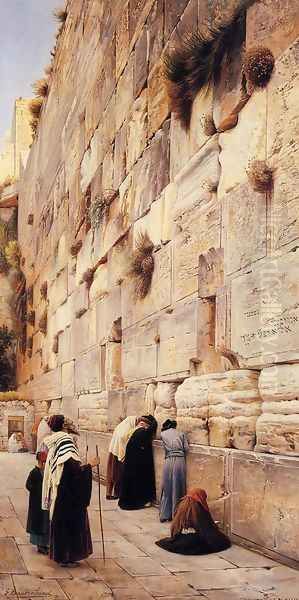
A pivotal moment in Bauernfeind's artistic development was his journey to Italy. Like many Northern European artists before him, including the Nazarenes such as Johann Friedrich Overbeck (1789-1869) or landscape painters like Joseph Anton Koch (1768-1839), Italy offered a rich tapestry of classical ruins, Renaissance art, and vibrant street life. For Bauernfeind, this experience seems to have whetted his appetite for the exotic and the historically rich, perhaps serving as a stepping stone towards the even more distant lands of the Levant. While his Italian works are less documented, it is understood that this period marked a gradual shift in his thematic interests.
The true turning point in his career came with his extensive travels to the Middle East. Between 1880 and 1882, Bauernfeind embarked on his first major journey, visiting Egypt, Palestine, Syria, and Turkey. This was followed by subsequent trips in 1887-1888 and 1890. These expeditions were not mere tourist excursions; they were immersive experiences that provided him with a wealth of sketches, studies, and firsthand observations that would fuel his artistic output for years to come. He was captivated by the dazzling light, the vibrant colors, the intricate architecture, and the diverse cultures he encountered.
The Orientalist Vision: Style and Subject Matter
Bauernfeind's artistic style is firmly rooted in Orientalism, a 19th-century Western artistic and literary movement that depicted the cultures, peoples, and landscapes of North Africa, the Middle East, and Asia. However, within this broad movement, Bauernfeind carved a unique niche. Unlike the more romanticized or sometimes sensationalized depictions by artists like Eugène Delacroix (1798-1863) or the highly polished, almost theatrical scenes of Jean-Léon Gérôme (1824-1904), Bauernfeind's work is characterized by a remarkable degree of verisimilitude and an almost documentary precision.
His architectural background shone through in his meticulous renderings of mosques, city gates, ancient ruins, and bustling marketplaces. He paid extraordinary attention to the textures of stone, the play of light and shadow on complex facades, and the intricate details of ornamentation. This precision did not come at the expense of atmosphere; indeed, his skillful manipulation of light – the harsh glare of the midday sun, the soft glow of twilight, or the dappled light filtering through a covered souk – imbued his scenes with a palpable sense of place and time. Artists like David Roberts (1796-1864) had earlier brought stunning architectural views of the Near East to Western audiences, and Bauernfeind continued this tradition but often with a greater focus on the human element within these settings.
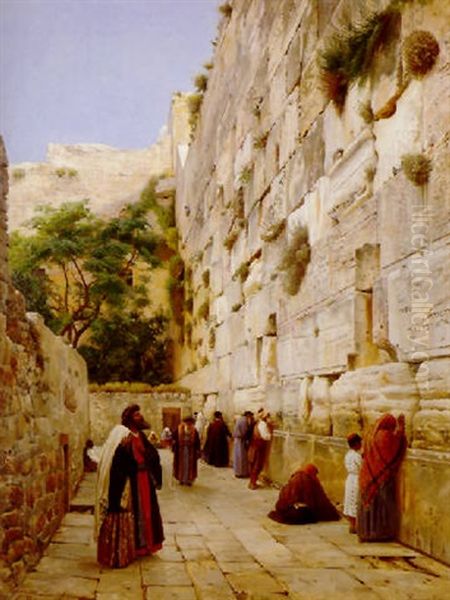
His subject matter was diverse, ranging from grand architectural vistas to intimate scenes of daily life. He painted the sacred sites of Jerusalem, the bustling markets of Jaffa and Damascus, the courtyards of ancient mosques, and the quiet alleyways of old cities. Figures in his paintings, whether merchants, worshippers, or simply passersby, are rendered with care, their attire and activities contributing to the overall authenticity of the scene. He shared this interest in the daily life and detailed settings with contemporaries like Ludwig Deutsch (1855-1935) and Rudolf Ernst (1854-1932), both Austrian-born painters active in Paris, who also produced highly finished, detailed Orientalist scenes.
Masterpieces of Precision and Atmosphere
Several of Gustav Bauernfeind's works stand out as iconic examples of his skill and vision.
_The Wailing Wall, Jerusalem_ (also known as _The Western Wall_) (versions from c. 1880s): This is perhaps his most famous and reproduced painting. Bauernfeind depicted the Western Wall, a site of immense religious significance for Judaism, with profound sensitivity and accuracy. He captured the fervent devotion of the worshippers, the ancient stones of the Wall, and the unique atmosphere of the location. The painting is a tour de force of detail, from the individual expressions of the figures to the textures of their garments and the inscriptions on the Wall. The careful rendering of light emphasizes the solemnity and historical weight of the scene.
_The Gate of the Great Umayyad Mosque, Damascus_ (c. 1889-1890): This monumental work showcases Bauernfeind's mastery of architectural painting and his ability to capture the vibrancy of urban life. The imposing gate, with its intricate Islamic geometric patterns and towering minaret, dominates the composition. Around it, a diverse crowd of figures engages in various activities, bringing the scene to life. The interplay of sunlight and shadow across the vast stone surfaces is rendered with exceptional skill, creating a sense of depth and realism.
_Market in Jaffa_ (various versions, e.g., 1887): Bauernfeind painted several views of the bustling port city of Jaffa. These works are filled with the sights, sounds, and energy of a Middle Eastern marketplace. Merchants display their wares, animals and people throng the narrow streets, and the architecture provides a rich backdrop. His ability to manage complex compositions with numerous figures and intricate details, while maintaining a sense of order and clarity, is particularly evident in these market scenes. John Frederick Lewis (1804-1876), a British Orientalist, was also renowned for his incredibly detailed depictions of Cairo street life and interiors, and Bauernfeind's market scenes share a similar commitment to capturing the richness of the everyday.
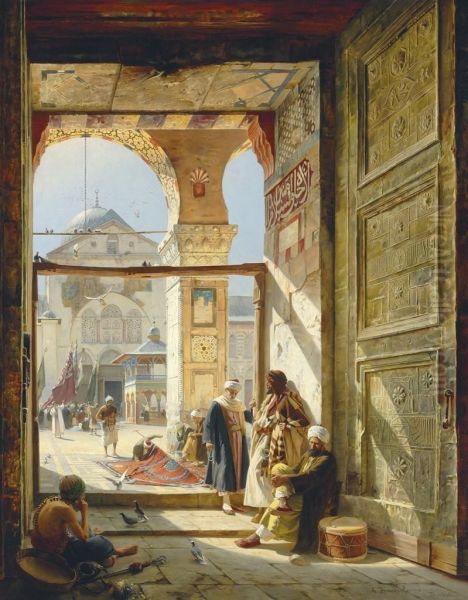
_The Great Hall of Würzburg University_ (1879): While not an Orientalist piece, this earlier work demonstrates his technical prowess in depicting complex interior architecture even before his full immersion in Middle Eastern subjects. It highlights his foundational skills that would later be applied to the mosques and palaces of the Levant. The precision seen here is reminiscent of the veduta painters like Canaletto (1697-1768) or Bernardo Bellotto (1721-1780), though applied to an interior rather than a cityscape.
These paintings, among many others, reveal Bauernfeind's dedication to capturing not just the visual appearance of the Orient, but also its cultural and historical essence. His works often possess a quiet dignity, avoiding overt exoticism in favor of a more observational approach.
Life in the Levant: A Deeper Immersion
Unlike many of his Orientalist contemporaries who made periodic trips to the East but remained based in Europe, Gustav Bauernfeind made the significant decision to permanently relocate. In 1896, he moved with his wife Elise and their son Otto to Palestine. They initially settled in the German Colony in Jerusalem in 1898. This move allowed him an unparalleled opportunity for sustained observation and deeper immersion in the local culture and environment.
Living in Jerusalem, and later spending time in Lebanon and Syria, Bauernfeind was no longer an occasional visitor but a resident. This proximity to his subjects undoubtedly enriched his work, allowing him to capture nuances that might escape a more transient observer. He continued to paint prolifically, focusing on the architectural marvels and daily life of the Holy Land and its surroundings. There is an anecdote that he created a watercolor album that was presented to Kaiser Wilhelm II of Germany, highlighting his connection to the German community and his growing reputation.
Despite his talent and dedication, Bauernfeind, like many artists, faced financial challenges throughout much of his career. The market for Orientalist art was competitive, and while his works were admired for their skill, achieving consistent financial success was an ongoing struggle. His decision to live in the Levant may have also presented commercial challenges, being further removed from the main art markets of Europe.
Artistic Influences and Connections
Bauernfeind's art was shaped by several influences. His architectural training provided the bedrock of his precision. His studies under Wilhelm von Diez at the Munich Academy grounded him in the realist traditions prevalent in Germany at the time. The broader Orientalist movement, with pioneers like Delacroix and established masters like Gérôme, certainly provided a context and a market for his chosen subject matter.
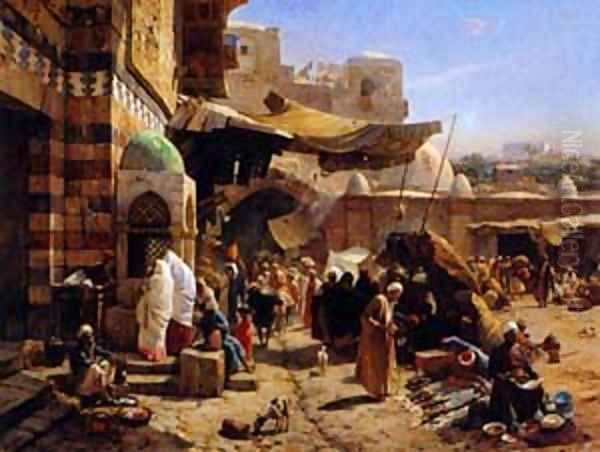
While direct collaborations are not extensively documented, he was part of a wave of European artists drawn to the Middle East. Austrian painter Leopold Carl Müller (1834-1892), for instance, was highly successful with his depictions of Egyptian life, often characterized by a vibrant use of color and light, offering a slightly different, perhaps more painterly, approach compared to Bauernfeind's meticulousness. The photographic quality often ascribed to Bauernfeind's work also suggests an awareness of the developing medium of photography, which was increasingly being used to document foreign lands. However, his paintings go beyond mere photographic reproduction, imbued as they are with artistic interpretation, compositional choices, and a masterful handling of light and color that only a skilled painter could achieve.
The influence of Bauernfeind's work, though perhaps not as widely disseminated during his lifetime as some of his contemporaries, has seen a resurgence. His paintings are now highly sought after by collectors and museums. Interestingly, his detailed and atmospheric depictions have found resonance even in modern media. For example, his work has been cited as an inspiration for the visual style of certain video games, such as by Truitt Intai, art director for the game "Sorcery," who referenced Bauernfeind's Jerusalem imagery. AnimationXpress also noted that their team drew inspiration from 18th and 19th-century Orientalist painters, including Bauernfeind, for a film project, aiming for a painterly aesthetic. This demonstrates the enduring power of his visual storytelling.
Legacy and Rediscovery
Gustav Bauernfeind passed away in Jerusalem on December 24, 1904, at the age of 56. For several decades after his death, his work, like that of many academic and Orientalist painters, fell somewhat out of favor as modernist art movements came to dominate the art world. The term "Orientalism" itself later came under critical scrutiny, particularly following Edward Said's influential 1978 book, for its potential to perpetuate colonialist perspectives and stereotypes.
However, from the 1980s onwards, there has been a significant re-evaluation and renewed appreciation for 19th-century academic and Orientalist art. Bauernfeind's paintings began to reappear in exhibitions and achieve remarkable prices at auction. For instance, his painting Mourning at the Temple (another title for a Wailing Wall scene) fetched £236,000 at Christie's in London in 1992. In 2007, The Port of Jaffa sold for £455,000 at Sotheby's. These sales underscored his status as one of the foremost painters of his genre.
His legacy lies in his extraordinary ability to transport the viewer to the 19th-century Middle East. His paintings are not just aesthetically pleasing; they are valuable historical documents, capturing architectural details, street scenes, and ways of life that have since been altered or have vanished. His commitment to accuracy, combined with his artistic skill, ensures that his works continue to fascinate and inform. He managed to convey both the grandeur of the historical sites and the human-scale activities that animated them, creating a rich and multifaceted portrait of the Orient.
Conclusion: A Master of Detail and Atmosphere
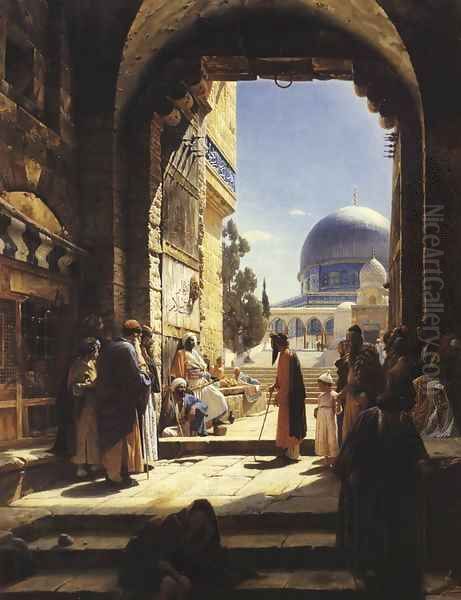
Gustav Bauernfeind's contribution to Orientalist art is significant and enduring. From his early training in architecture to his immersive life in the Levant, his artistic journey was one of dedication to capturing the world around him with unparalleled precision and sensitivity. His paintings of Jerusalem, Damascus, Jaffa, and other Middle Eastern locales are masterpieces of detail, light, and atmosphere. They offer a window into a bygone era, rendered with a skill that continues to command respect and admiration. While he may have struggled for widespread recognition during his lifetime, his rediscovery has solidified his place as a key figure in 19th-century German art and a remarkable chronicler of the Orient, whose works bridge the gap between meticulous documentation and profound artistic vision. His paintings invite us to look closely, to appreciate the intricate beauty of the world he depicted, and to marvel at the dedication of an artist who so faithfully brought it to life on canvas.